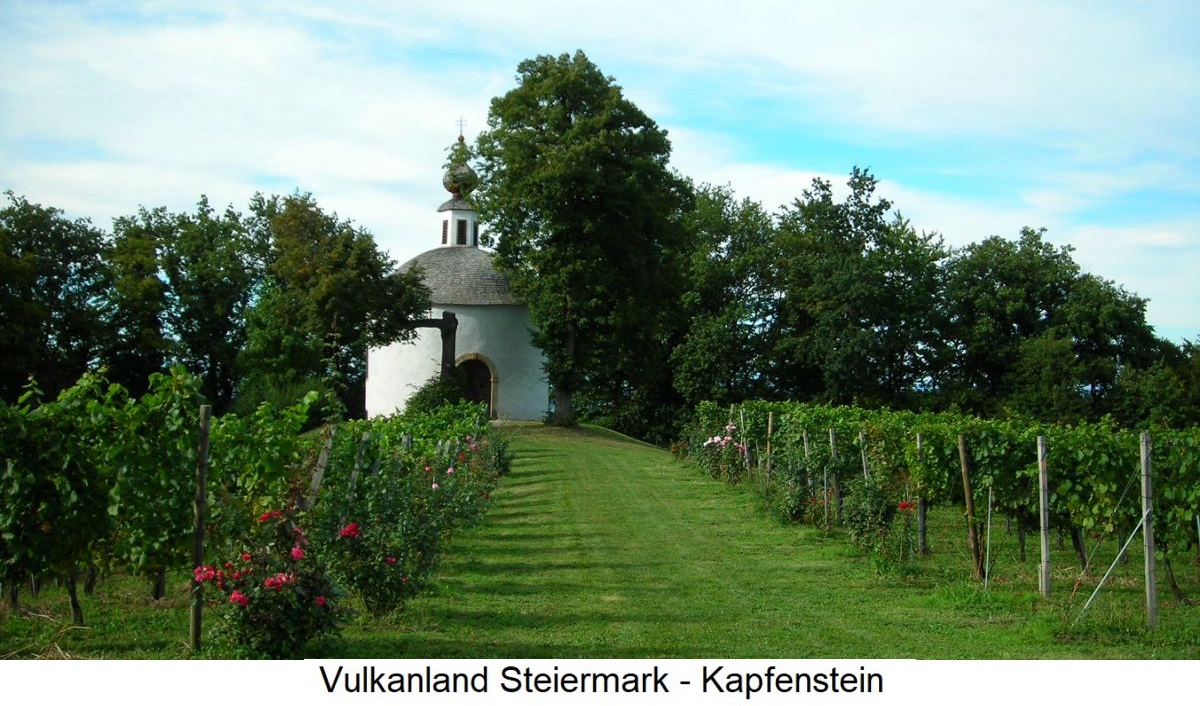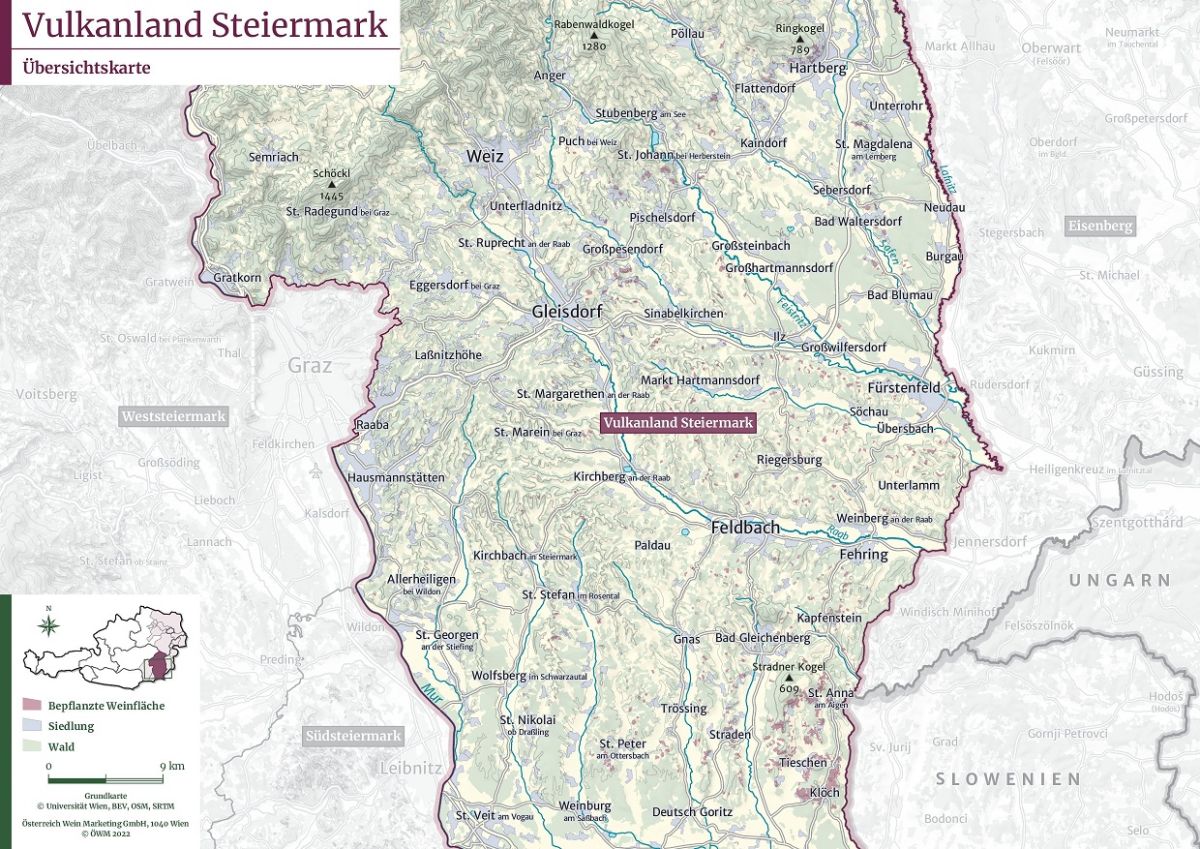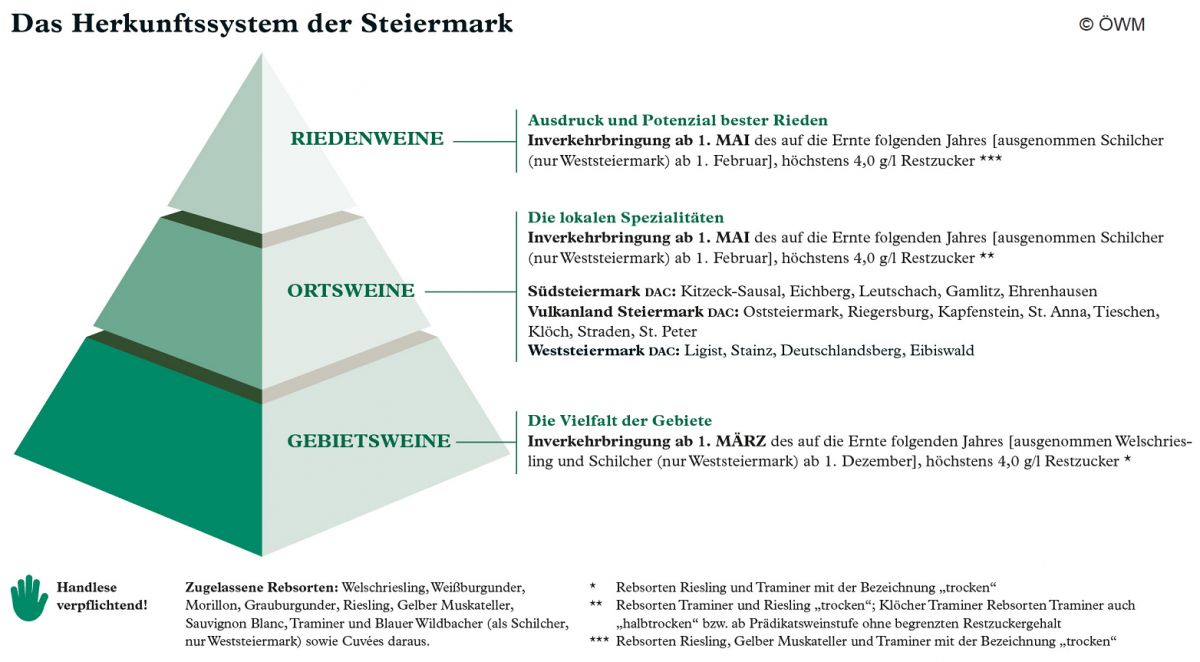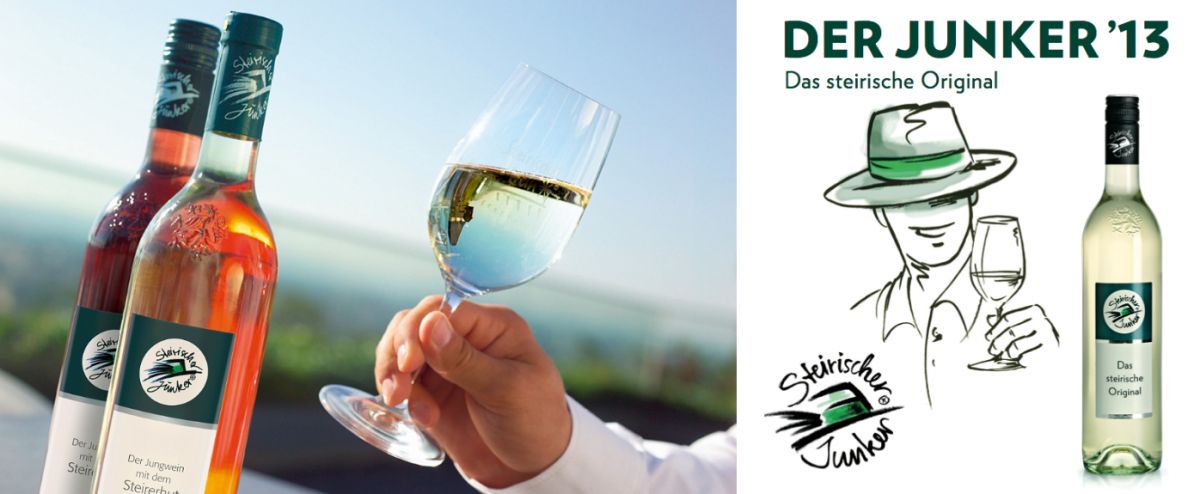Results
2,284 Results
Loading more Results ...
Loading more Results ...
| Vulkanland Steiermark |
Description to Vulkanland Steiermark
One of the three specific wine-growing regions in the Austrian province or generic wine-growing region of Styria. It lies close to the borders with Slovenia and Hungary, as well as Burgenland. The area formerly known as south-east Styria was renamed Vulkanland Steiermark in 2016. It is also known as the "Land of Castles and Palaces".

Climate & soils
In the north, there are vineyards at 650 metres above sea level on the Ringkogel near the municipality of Hartberg, which are among the highest vineyards in Austria. Climatically, this is a transition zone between the hot, dry Pannonian climate with little rainfall and the warm, humid Mediterranean climate. Volcanic soils with sandy loam, clay and weathered basalt predominate. The towering volcanic cones characterise the landscape and also gave it its new name. The two large vineyards are called Oststeirisches Hügelland and Steirisches Vulkanland.

Wine-growing communities
Four wine routes lead through the landscape characterised by gentle hills. Well-known wine-growing communities are Bad Radkersburg, Feldbach, Gleichenberg, Gleisdorf, Hartberg, Kapfenstein (vineyards An der Kapelle, Hinteregg, Rosenleiten), Klöch with the speciality "Klöcher Traminer", Riegersburg (vineyards Brunnenfeld, Festungsmauer, Turnierplatz), St. Anna am Aigen, St. Peter, Straden (vineyards Buchberg, Klausen), St. Anna am Aigen, Tieschen and Weiz. These are connected by the Klöcher Wine Route, Thermenland Wine Route, South-East Styrian Hill Country Wine Route and East Styrian Roman Wine Route.
Grape variety index
In 2022, the vineyards covered a total of 1,657 hectares of vines. Compared to 2016 with 1,524 hectares, this was an increase of 133 hectares (9%). White wine varieties account for 1,408 hectares (85%) and red wine varieties for 249 hectares (15%). Welschriesling dominates the white wine varieties, followed by Pinot Blanc and Sauvignon Blanc. The red wine varieties are dominated by Zweigelt, followed by Blauer Wildbacher and Merlot. The Muscaris, Muscat, Sauvignon Blanc, Souvignier Gris and Pinot Blanc varieties were promoted, while Müller-Thurgau and Blauburger were relegated.
Grape variety
|
in Austria
|
colour |
HA
|
%-Ant
|
HA
|
%-Ant
|
| Welschriesling | - | white | 319 | 19,2 | 310 | 20,3 |
| White Burgundy | Pinot Blanc, Klevner | white | 291 | 17,6 | 240 | 1507 |
| Zweigelt | Blauer Zweigelt, Rotburger | red | 146 | 8,8 | 177 | 11,6 |
| Sauvignon Blanc | Muscat Sylvaner | white | 173 | 6,4 | 108 | 7,1 |
| Muscat | Yellow M., Red M. / Muscat Blanc | white | 138 | 8,3 | 66 | 4,3 |
| Chardonnay | Morillon | white | 113 | 6,8 | 93 | 6,1 |
| Müller-Thurgau | Rivaner | white | 76 | 4,6 | 103 | 6,8 |
| Grey Burgundy | Pinot Gris, Ruländer | white | 61 | 3,7 | 35 | 2,3 |
| Scheurebe | Seedling 88 | white | 51 | 3,1 | 59 | 3,8 |
| Traminer | Gewürztraminer, Roter T., Gelber T. | white | 38 | 2,3 | 37 | 2,4 |
| Muscaris | - | white | 27 | 1,6 | - | - |
| Blauer Wildbacher | - | red | 25 | 1,5 | 32 | 2,1 |
| Souvignier Gris | - | white | 25 | 1,5 | - | - |
| White Riesling | Riesling Rhine Riesling | white | 21 | 1,2 | 24 | 1,5 |
| Merlot | - | red | 16 | 0,9 | 14 | 0,9 |
| Goldburger | - | white | 11 | 0,7 | 25 | 1,6 |
| Pinot Noir | Pinot Noir, Pinot Noir | red | 8 | 0,5 | 9,4 | 0,6 |
| Blue Burgundy | - | red | 7 | 0,4 | 13 | 0,9 |
| Cabernet Sauvignon | - | red | 7 | 0,4 | 8,4 | 0,6 |
| Blossom muscatel | - | white | 6,5 | 0,4 | - | - |
| St Laurent | - | red | 6 | 0,3 | 7,5 | 0,5 |
| Roesler | - | red | 5 | 0,3 | 4,6 | 0,3 |
| Blaufränkisch | - | red | 3 | 0,2 | 3,7 | 0,2 |
| Grüner Veltliner | White plum | white | 3 | 0,2 | 2,8 | 0,2 |
| Syrah | Shiraz | red | 3 | 0,2 | 1,8 | 0,1 |
| Sylvaner | Green Sylvaner | white | 2 | 0,1 | 2,6 | 0,2 |
| Furmint | - | white | 2 | 0,1 | 0,2 | - |
| Muscat Ottonel | - | white | 1,3 | 0,1 | 1,4 | 0,1 |
| Rathay | - | red | 1 | 0,1 | 0,6 | - |
| Bouvier | - | white | 0,5 | - | - | - |
| Cabernet Franc | - | red | 0,3 | - | 0,3 | - |
| Gold muscatel | - | white | 0,2 | - | - | - |
| Frühroter Veltliner | Malvasia | white | 0,1 | - | - | - |
| other varieties | - | white/red | 76 | 4,6 | 147 | 9,6 |
WHITE VARIETIES |
- |
white |
1.408 |
85 |
1.219 |
80 |
RED VARIETIES |
- |
red |
249 |
15 |
305 |
20 |
TOTAL |
|
|
1.657 |
|
1.524 |
|
DAC system
The Vulkanland Steiermark DAC area comprises the political districts of south-east Styria, Hartberg/Fürstenfeld and Weiz as well as municipalities in the Leibnitz district on the left bank of the Mur. The cross-local wine-growing communities are Klöch, Straden, St. Peter, Tieschen, St. Anna, Kapfenstein, Riegersburg and Oststeiermark. The leading varieties are Sauvignon Blanc (for all wine-growing communities), Pinot Blanc (for Oststeiermark, Riegersburg, Kapfenstein, St. Anna, St. Pater), Burgundy Cuvée (for Tieschen), Traminer (for Klöch) and Pinot Gris (for Straden).
The origin-based DAC system was introduced in Styria in 2018. All other quality wines must be marketed with the origin Styria, the regional wines under the wine-growing region designation Steirerland. In contrast to the Austrian provinces of Burgenland and Lower Austria (where the individual regions were realised one after the other), an overall concept was developed for all three specific wine-growing regions. There is a three-level pyramid of origin with the levels of regional wine, local wine and Riedenwein. The DAC pyramid:

The Styrian diversity of varieties is taken into account in different ways (see the varieties in the diagram above). In the case of regional wines, it is retained, while in the case of local wines and in some cases also Riedenwein, local leading varieties have been defined differently for each wine-growing region. Regional wines may be marketed from 1 March, single vineyard wines and local wines from 1 May of the year following the harvest. An exception is made for wines from the Welschriesling and Schilcher Klassik varieties (only in Western Styria), which may be marketed as regional wines from 1 December of the harvest year and as local wines from 1 February of the year following the harvest. There is also an exception for the Steirischer Junker brand wine created by the Wein Steiermark association, which is traditionally presented at the beginning of November.

Producers
Well-known wineries include Erzherzog Johann Weine, Frauwallner Walter, Frühwirth Fritz, Gießauf-Nell, Gölles, Herrenhof Lamprecht, Krispel, Neumeister, Platzer Manfred, Ploder-Rosenberg, Pock Franz, Thaller Koarl and Winkler-Hermaden.
Kapfenstein: © ÖWM - Gerhard Elze
Map and DAC pyramid: © ÖWM
Styrian Junker: Toni Muhr
Classified wine producers in Vulkanland Steiermark 25
find+buy for Vulkanland Steiermark 18
Recent wines 546
 Weingut Winkler-Hermaden
— Styria/Steiermark
2013 Vulkanland Steiermark Ried Winzerkogel Pinot Noir trocken
90 WP
excellent
Weingut Winkler-Hermaden
— Styria/Steiermark
2013 Vulkanland Steiermark Ried Winzerkogel Pinot Noir trocken
90 WP
excellent

 Weingut Pfeifer
— Styria/Steiermark
2021 Vulkanland Steiermark Blauer Zweigelt trocken
8.70 €
Weingut Pfeifer
— Styria/Steiermark
2021 Vulkanland Steiermark Blauer Zweigelt trocken
8.70 €

 Weingut Pock
— Styria/Steiermark
2016 Vulkanland Steiermark Cuvée "P"
90 WP
excellent
26.70 €
Weingut Pock
— Styria/Steiermark
2016 Vulkanland Steiermark Cuvée "P"
90 WP
excellent
26.70 €

 Weingut Winkler-Hermaden
— Styria/Steiermark
2018 Vulkanland Steiermark Pinot Noir Reserve trocken
87 WP
very good
18.00 €
Weingut Winkler-Hermaden
— Styria/Steiermark
2018 Vulkanland Steiermark Pinot Noir Reserve trocken
87 WP
very good
18.00 €

The most important grape varieties
More information in the magazine
- Discover Chardonnay in an entirely new way Unusual pairing tips from René Kollegger
- Sauvignon Blanc above all Wine-growing regions in Austria: Südsteiermark
- In the land of the Schilcher Wine-growing regions in Austria: Weststeiermark
- On a pleasure trip through the Vulkanland Steiermark Insider tips: Wine, specialities and delicacies
- Weingut Gross - The art of winemaking - Advertisement -
- In Focus: Styrian Sauvignon Blanc The red thread
- Styrian Sauvignon Blanc: great vintages now available People in Styria will be talking about 2019, 2020 and 2021 for a long time - Advertisement -
- Collection of the Year 2021 - Styria Neumeister Winery
- Hail protection versus landscape protection How the use of hail nets is changing viticulture in Austria
- Austria In Focus Styrian single vineyards